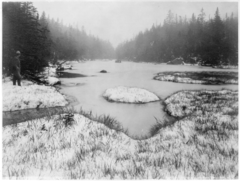Lake Tear of the Clouds
| Lake Tear of the Clouds | |
|---|---|
 by Seneca Ray Stoddard (late 19th century) | |
| Location | Essex County, New York |
| Coordinates | 44°06′24″N 73°56′09″W / 44.10667°N 73.93583°WCoordinates: 44°06′24″N 73°56′09″W / 44.10667°N 73.93583°W |
| Type | tarn |
| Primary inflows | unnamed streams |
| Primary outflows | Feldspar Brook |
| Basin countries | United States |
| Surface elevation | 4,293 ft (1,309 m) |
Lake Tear of the Clouds (44°06′25″N 73°56′09″W / 44.1069°N 73.9359°W) is a small tarn located in the town of Keene, in Essex County, New York, United States, on the southwest slope of Mount Marcy, the state's highest point, in the Adirondack Mountains. It is the highest pond in the state. It is often cited as the highest source of the Hudson River,[1] via Feldspar Brook and the Opalescent River, even though the main stem of the Opalescent River has as its source a higher point two miles north of Lake of the Clouds, and that stem is a mile longer than Feldspar Brook.
The Hudson River as named actually begins several miles southwest at Henderson Lake in Newcomb, New York.[2][3][4]
The lake was discovered in 1872, by Verplanck Colvin while he was surveying the Adirondack Mountains. He wrote:
| “ | Far above the chilly waters of Lake Avalanche at an elevation of 4,293 feet lies summit water, a minute, unpretending, tear of the clouds — as it were — a lovely pool shivering in the breezes of the mountains and sending its limpid surplus through Feldspar Brook to the Opalescent River, the well-spring of the Hudson. | ” |
On September 14, 1901, then-US Vice President Theodore Roosevelt was at Lake Tear of the Clouds after returning from a hike to the Mount Marcy summit when he received a message informing him that President William McKinley, who had been shot two weeks earlier but was expected to survive, had taken a turn for the worse. Roosevelt hiked down the mountain to the closest stage station at Long Lake, New York. He then took a 40 miles (64 km) midnight stage coach ride through the Adirondacks to the Adirondack Railway station at North Creek, where he discovered that McKinley had died. Roosevelt took the train to Buffalo, New York, where he was officially sworn in as President.[5] The 40-mile route is now designated the Roosevelt-Marcy Trail.[6]
References
- ↑ "Natural History of the Hudson River". Hhr.highlands.com. Retrieved February 16, 2014.
- ↑ U.S. Geological Survey Geographic Names Information System: Hudson River
- ↑ U.S. Geological Survey Geographic Names Information System: Indian Pass Brook
- ↑ U.S. Geological Survey Geographic Names Information System: Calamity Brook
- ↑ "Adirondack Journal — An Adirondack Presidential History". http://www.adkmuseum.org/''. Adirondack Museum. Retrieved February 4, 2015.
- ↑ "Roosevelt-Marcy Byway". https://www.dot.ny.gov''. NewState Department of Transportation. Retrieved February 4, 2015.